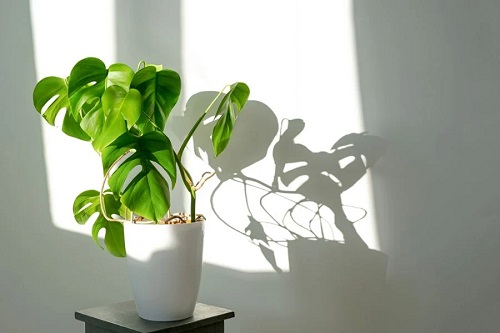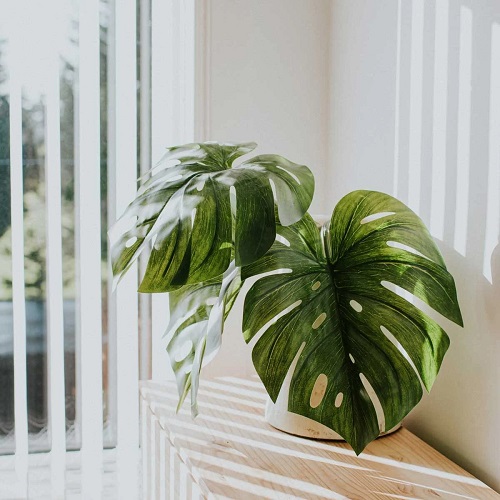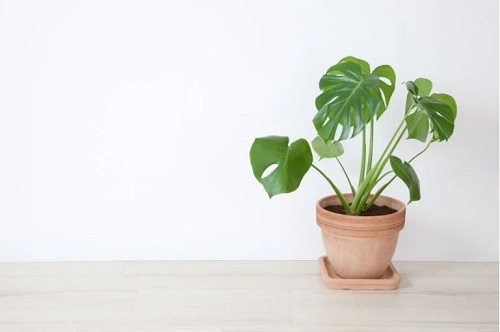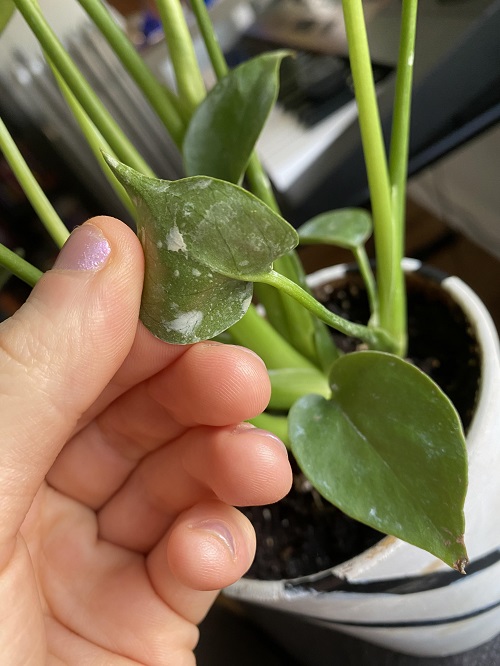Here are the Common Monstera Plant Problems and Their Solutions that will help you to grow this plant easily without any fuss.
Do you know about the most Common Monstera Plant Problems and Their Solutions? If not, then we have a detailed list to guide you!
Check out the Best Mini Monstera Varieties here
Common Monstera Plant Problems and Their Solutions
1. Leaves Curling

Curling leaves of monstera are a sign of stress; it can be due to underwatering, temperature change, pest problems, and low humidity. The new leaves of the plant also curl, and it is normal.
Reasons and Solution
This can also be possible if the plant is getting too much sunlight and very less moisture. In such a case, change the plant’s location and keep it in an area that has stable conditions and gets a mix of dappled light and shade till you see the leaves open up again.
Also, water the plant well and mist the foliage to help it fight the stress.
Note: Do not overwater the plant in this situation. Water well and then wait till the topsoil feels a little dry to the touch and then moisten again.
Monstera Leaves Curling? Learn How to Fix Them
2. Root Rot

Generally, root rot is triggered by too much moisture or regular overwatering. A pot without drainage holes or poorly draining soil can also speed up this issue.
Low light is also a problem since it will slow down photosynthesis and evaporation, and the plant, in that case, won’t be able to use the water.
The symptoms of root rot can be mixed—browning, yellowing, and blackening of the foliage, along with drooping and curling of leaves, are common.
Reasons and Solution
Take the plant out of the pot and give the roots a thorough inspection, looking for mushy, brown, and black roots. You can easily separate them as they will carry a foul smell.
Using a pair of shears, snip away the damaged parts of the roots, keeping the healthy section intact. Once done, re-pot the plant in a new pot filled with a dry and well-draining potting mix. To learn more about saving an overwatered plant–click here!
Check out the Best Monstera Albo Varieties You Must Grow
3. Leaves Turning Yellow
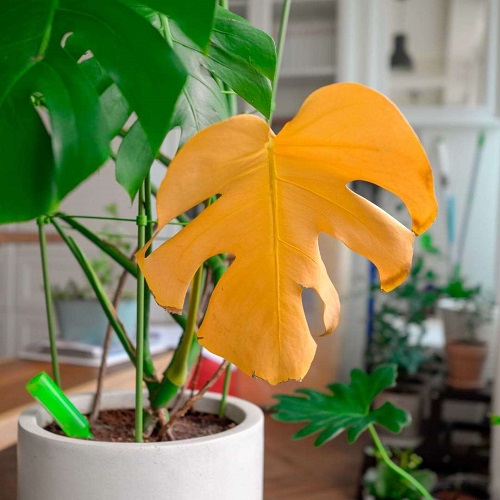
Not just with monstera, yellowing leaves are a common issue with most houseplants. The main reason behind this problem is overwatering and lack of light.
Reasons and Solution
Avoid watering the plant on a daily basis, and do it only when the topsoil feels a little dry to the touch.
Inappropriate drainage is also one of the reasons behind the leaves taking a yellow hue. Make sure the pot has a drainage hole at the bottom, and also use a well-draining growing medium.
Check out all the causes and solutions for monstera leaves turning yellow
4. Brown Leaf Tips
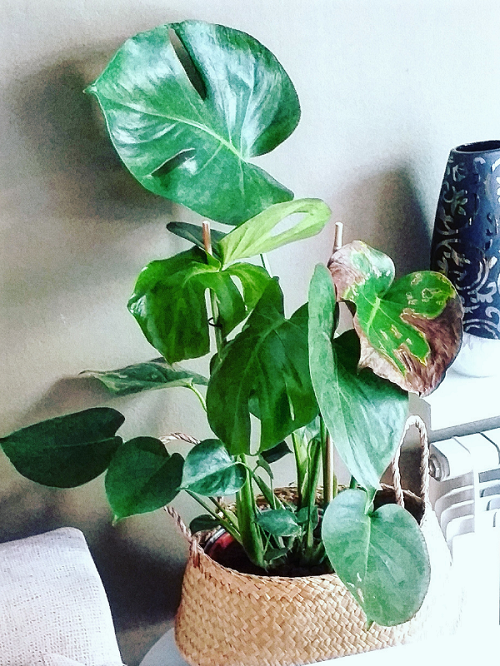
The main reasons that can cause brown leaf tips are lack of water, insufficient humidity, and over-fertilization.
Reasons and Solution
To solve this issue, keep the soil moist, but don’t make it soggy. Check the top layer of soil regularly with your fingers—if it feels dry, upto 1-2 inches, water the plant.
To ensure the plant gets sufficient humidity, keep its pot on a pebble tray filled with water. You can also get a humidifier or mist the leaves every alternate day. Grouping 2-3 plants together is also a good idea to boost the humidity level around plants.
Over-fertilization is also the reason behind it. Make sure you are not feeding the plant way too frequently.
5. Black Leaves

Deep brown or black edges and spots on the leaves are due to inappropriate watering methods and can happen by both under and overwatering.
Exposure to direct sun can also burn the leaves. Root rot is another reason that can lead to this issue. Over or under-feeding can also make foliage black.
Reasons and Solution
Keep the soil well-watered so that the plant stays constantly moist. Though, this doesn’t mean that you drench the soil wet. The moment the growing medium feels dry to the touch, water the plant.
Place your monstera where it gets bright indirect light during all parts of the day.
Over or under-fertilization can also cause black leaves—do not feed the plant more than once in 5-6 weeks using a balanced liquid fertilizer diluted to 1/2 of its strength.
6. Yellow Spots

Improper watering leads to yellow spots on the foliage. Fungal issues can also be the reason behind it. If untreated, it can result in other issues, like making the whole leaf brown or yellow.
Reasons and Solution
Make sure the moisture-related requirements are met through watering properly. Also, use a well-draining growing medium and take care of the plant’s humidity requirements.
It may also be due to pests and fungal issues; treat it with an insecticidal soap solution.
7. No Fenestration

The prime attraction of monstera leaves is their fenestration. The age of the plant, season and light affect the splits and cuts on the foliage.
Reasons and Solution
Young leaves commonly don’t show any splits—the plant needs to be matured enough to develop holes and splits.
When the plant is dormant, it won’t create cuts in the leaves. The foliage won’t split until the temperature increases and the growing season starts.
Choose a location where the light hits the plant from the top. This will trick the plant into splitting the leaves to allow the light to reach the lower leaves.
Learn How to Get Split Leaves on Monstera
8. Wilting
Under watering, temperature, pests, or shock can cause wilting or drooping monstera.
Reasons and Solution
Droopy foliage indicates that the plant needs moisture. Never under or over-water your monstera. Water when the topsoil turns dry up to 1 inch.
Sudden fluctuations in temperature can lead to droopy leaves. Do not keep the plant near A/C or heating vents.
Transplantation shock can make the leaves droopy. Don’t worry if it happens; the plant will bounce back in a few weeks.
Check for bugs if leaves are bent. Pests like aphids can suck out the sap and harm the roots, causing the foliage to droop.
9. No New Foliage
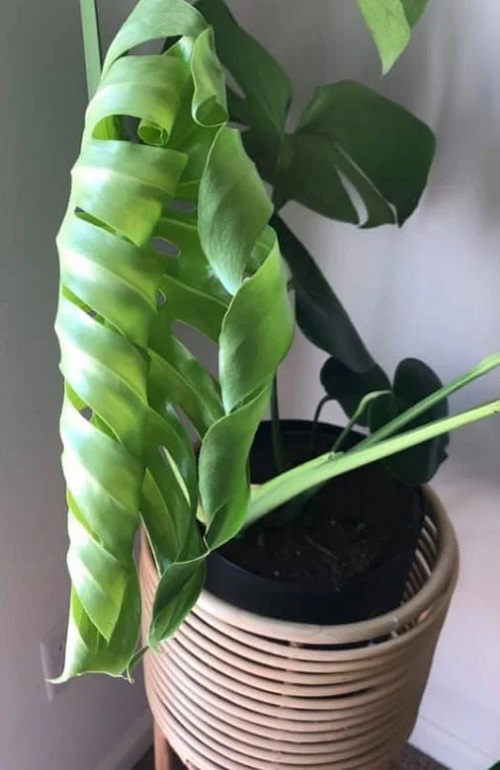
If you see that the plant is not growing any new foliage, then it can be due to many factors.
Reasons and Solution
When the plant goes into the dormancy stage in the cold months of the year, it stops growing new leaves. This is due to the fact that it saves energy for the spring and summer months.
No new leaves in the growing season indicate that your monstera is stressed out. Improper light and water can be the causes. Severe root-bound can also be the reason—re-pot the plant into a one-size big pot with drainage holes using fresh soil.
10. Brown Spots

Deep brown and black spots and patches on the leaves can also be common issues with these plants.
Reasons and Solution
If the roots are damaged, then it is always a good idea to snip them away, keeping the best ones intact, as root rot cannot be treated. Take the plant out from the pot, remove the damaged root parts, and re-pot it into a new container with a fresh growing medium.
Brown spots can be due to direct sunlight exposure for prolonged periods. To avoid this, place the plant where it gets indirect bright light.
Small brown spots on the leaves can be due to pests, too. Use insecticidal soap solution to get rid of them.
11. Slow Plant Development
If you see the plant not growing in the way it should, then it might be due to several reasons.
Reasons and Solution
Improper light exposure, too much or too little watering, and less humidity can hamper the plant’s growth.
Growing a small plant in a huge container can also slow down growth. So always make sure the pot is a maximum of 1-2 sizes bigger than the root ball of the plant.
Growth can be impacted by the root-bound state as well—re-pot the plant once in 1-2 years, depending on the growth. Have a look at the Top Mistakes to Avoid When Repotting Houseplants here.
Follow Tips and Tricks to Grow a Big & Bold Monstera
12. Leggy Growth
Insufficient light and lack of maintenance can cause leggy growth.
Reasons and Solution
Keep the plant where it gets bright indirect light for the most part of the day. Keep it safe from harsh afternoon sunlight exposure, especially in warmer zones. An east or west-facing window will be a perfect location.
Follow a healthy pruning routine and trim away any leggy, stretched, and damaged foliage. Pruning regularly promotes bushy and new growth.
13. Tearing Foliage
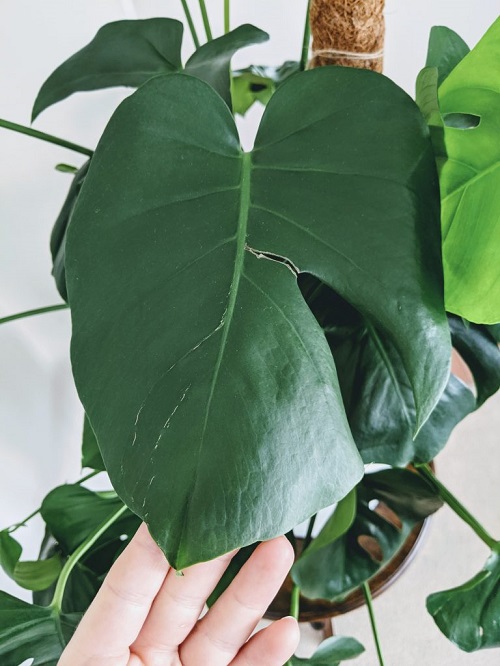
This can be due to excessive or lower sunlight exposure, pests, overwatering, or simply the plant having a mind of its own!
Reasons and Solution
Make sure the plant gets proper sunlight exposure and is safe from any pests and diseases. It may also happen due to the mistreatment and bad handling of plants.
14. Powdery Substance on Leaves
A fluffy white or brown powdery matter on monstera leaves is a sign of powdery mildew. This disease spreads fast and covers the entire plant.
Reasons and Solution
Isolate the plant immediately and prune the affected leaves. Make sure there is adequate airflow and sunlight exposure. Avoid misting or sprinkling water on the foliage.
Mealybugs can also leave a white powdery substance on the monstera leaves—get rid of this problem by wiping the foliage with a neem oil or insecticidal soap solution.
15. Unbalanced Growth
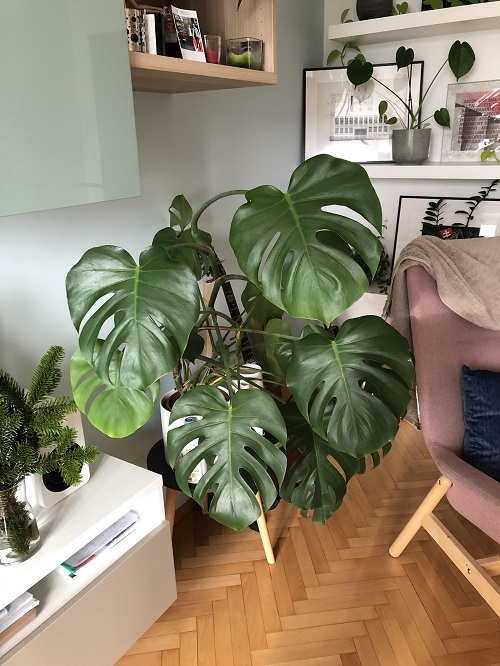
If one side of your monstera is growing longer, better, and larger than the other side, then it indicates that one section of the plant is receiving more sunlight than the other.
Reasons and Solution
To ensure every part of the plant gets proper sunlight exposure, it would be a good idea to rotate the plant every 2-3 days.
Do occasional pruning to ensure the light reaches every part and section of the plant.
16. Webbing Around Stems
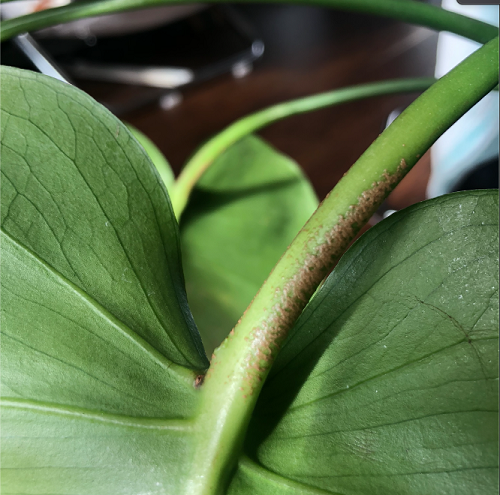
Spider mites make a noticeable webbing around stems and leaves. These pests are also the reason behind the red and yellow spots on the foliage.
Reasons and Solution
Spider mites are notorious and can damage the plant if left untreated. To get rid of this problem, make sure the moisture requirements of your monstera are fulfilled.
Spider mites prosper in dry environments, which monstera plants dislike. Promote the humidity around the plant and repel this nasty pest.
Find how to get rid of spider mites easily
17. Deformed Foliage
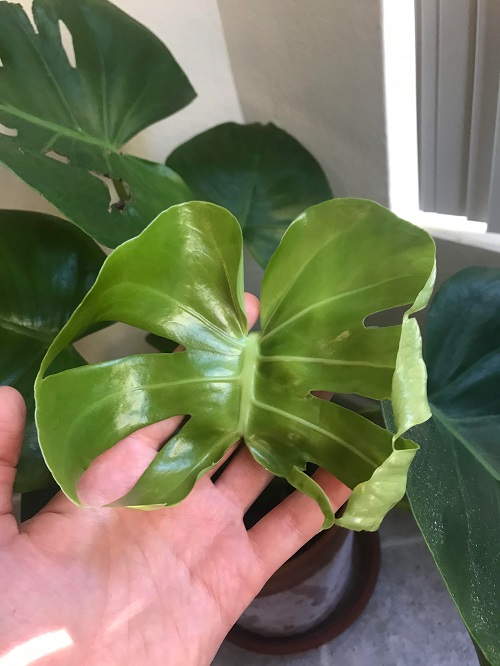
Deformed leaves indicate scale and aphid infestation. Mosaic viruses can also cause misshapen bumpy leaves.
Reasons and Solution
Unfortunately, there is no treatment for mosaic viruses—the best cure is prevention by keeping the plant safe from overwatering and exposing it to plenty of bright and indirect light.
When you spot scales, spider mites, aphids, or any pest, pick and crush them between your nails. Treat large infestations by using neem oil or an alcohol solution.

